Something is happening. Our most common creepy-crawling amphibian, the red-backed salamander, Plethodon cinereus, is beginning to go missing.
Outdoors
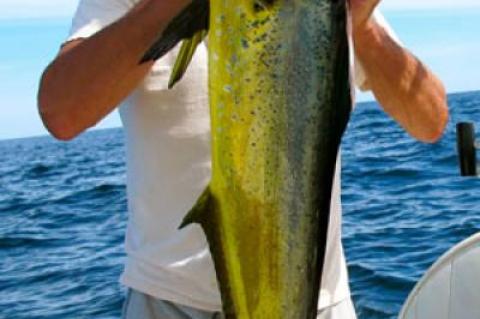 Sushi Alfresco, Anyone?
Sushi Alfresco, Anyone?If you’ve been in the ocean lately you know it’s hurricane warm, high 70s, a bit frightening for anyone who’s been around these parts for any length of time. It also means the Gulf Stream is making its presence known.
Not surprising then that pelagic migrators of all kinds, including mahimahi, billfish, and tuna, have appeared offshore. Late at night on Aug. 7, John Mazzella and crew slid into the Montauk Marine Basin dock with a big blue marlin. The scale was locked in the office, but the fish was estimated to weigh at least 800 pounds.
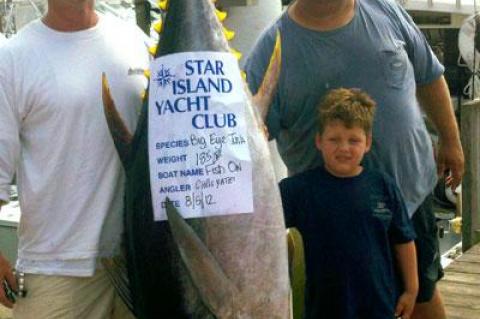 Just When You Thought . . .
Just When You Thought . . .Thirty-three boats brought 13 mako sharks — the largest a 148-pounder — to the scales at the 20th annual mako shark tournament held from the Star Island Yacht Club over the weekend, but it’s the number of large sharks being caught and seen relatively close to shore that has folks wondering.
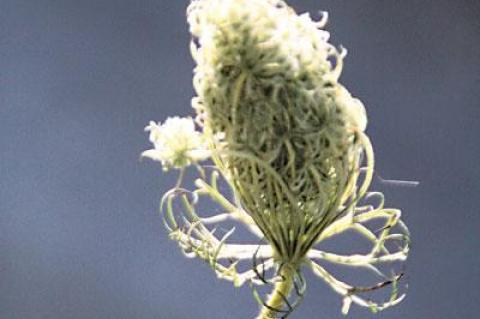 Nature Notes: What Deer Won’t Eat
Nature Notes: What Deer Won’t EatA month ago on a record hot Thursday, I attended a “poisonous plants” course conducted by Susan K. Pell, Ph.D., at the New York Botanical Garden. It was my first visit to that institution and one that turned out to be directly related to the vegetation in my Noyac yard.
I had wondered for more than 20 years why many of the plant species have been consistently untouched by the deer that routinely visit the yards of my neighbors.
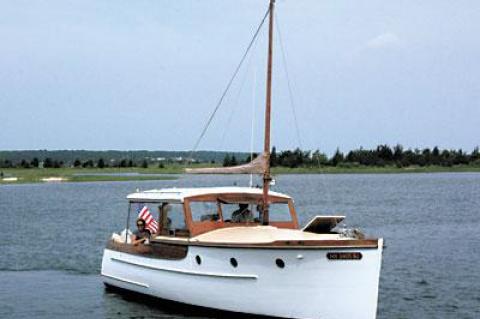 THE MARY LLOYD: ‘This Baby’s Got Class!’
THE MARY LLOYD: ‘This Baby’s Got Class!’Scott Faulkner said aboard his lovingly restored 1939 Elco cabin cruiser at Three Mile Marina the other day that when he first came across the Mary Lloyd it was shrouded by canvas in Jim Bennett’s storage and maintenance yard next to the Springs School.
“I had always seen the bow sticking out — it looked to me like an interesting package under the tree that you wanted to open but couldn’t.”
As we know, time and tide wait for no man, or woman for that matter. There’s really nothing that can be done to stem the first part of the old saw, but being aware of our semidiurnal tide schedule is crucial for sailors, fishermen, surfers, and habitual beach walkers.
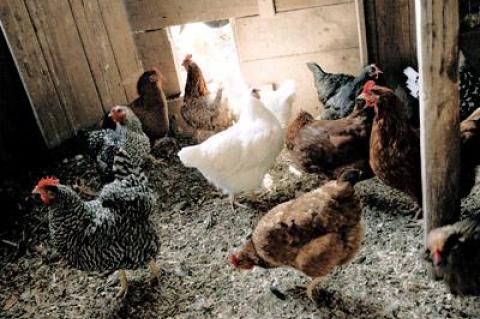 Nature Notes With a Cluck, Cluck Here
Nature Notes With a Cluck, Cluck HereAs Roseanne Roseannadanna used to say, “What’s all this fuss about chickens?”
Having been born and raised next to my grandfather’s chicken farm in Mattituck, where he tended a flock of up to 5,000 chickens, I am quite partial to them. You might say the first bird species I learned was the once-wild fowl, Gallus gallus, or in this case, white leghorn, and the first bird I ever heard sing was the rooster.
 PADDLEBOARDING: Vineyarder Wins 6-Miler
PADDLEBOARDING: Vineyarder Wins 6-MilerTwo events at Fresh Pond in Amagansett — one on land, one on the water — coincided Sunday, and in terms of numbers the paddleboarders, who raced three and six-mile triangular courses in Gardiner’s Bay that morning, outnumbered those who ran in the Old Montauk Athletic Club’s 5K on the roads nearby.
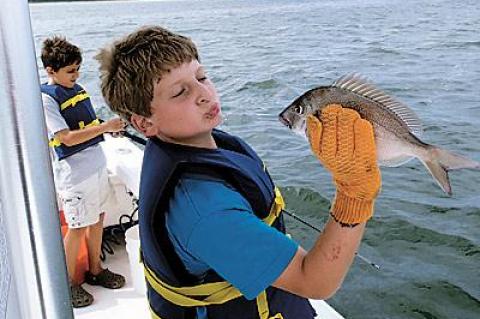 Big Scup Not Just a Fluke
Big Scup Not Just a FlukeWhile the summer cornucopia of fish continues to spill forth with an abundance found nowhere else on the coast, anglers have been heard to moan about how hard it’s been to find small porgies to use for bass bait. “They’re all the size of hubcaps,” one angler complained.
It’s true. Porgies, otherwise known as scup, seem to be getting larger and larger, as though their genetic material has been contaminated Godzilla-like by atomic radiation.
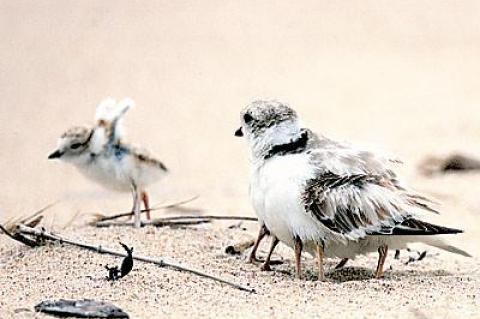 Nature Notes: Going Native
Nature Notes: Going NativeNative plants not only produce stuff that you can eat, but also attract insects, so if you convert a lawn into a natural habitat and include different native plant communities — we’ll call them micro communities — you will increase diversity of the resident fauna to the max.
More and more local people are doing this.
The Coast Guard Auxiliary Flotilla 18-02 is offering a boating safety course at the American Legion Hall on Bay Street in Sag Harbor on two Saturdays — Aug. 4 and Aug. 11.
Both classes are required in order to earn a New York boating certificate. The cost is $50. Interested boaters can register and ask questions by e-mailing cgaux[email protected] or calling Tish at 516-818-0347.
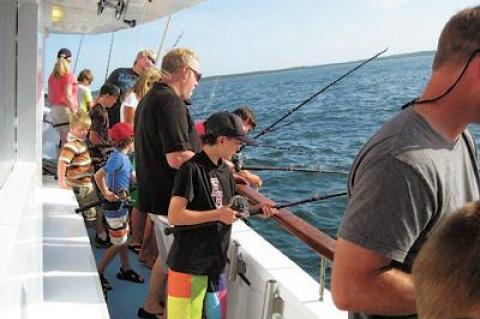 Deep in the Slack Tide
Deep in the Slack TideThe sloop Leilani ventured west out of Montauk Harbor on Sunday to the waters off Eastern Plains Point on Gardiner’s Island in search of the dinner plate-size porgies said to lurk in the area.
A two-hook porgy rig, clam baits, bucket, fillet knife, cutting board — all the ingredients for a successful venture were on board. Leilani tacked into a weak west wind and a stronger outgoing tide — slow going.
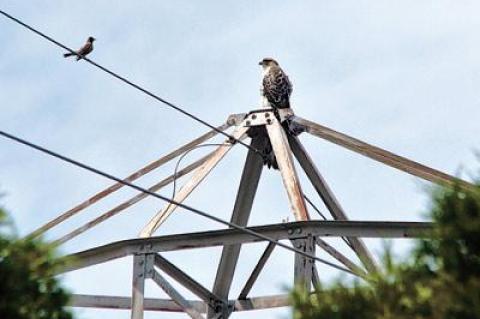 Nature Notes: An Exquisite Surprise
Nature Notes: An Exquisite SurpriseThere are a lot of things I would like to see for the first time before I give up the ghost. I have a list of them — five pages long — that I keep adding to. On occasion Saint Serendipity takes me to one not on my list.
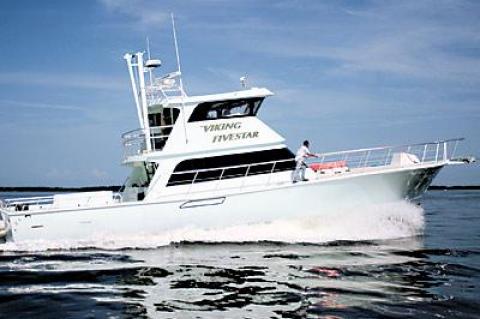 ‘The Sound of Silence’
‘The Sound of Silence’The sloop Leilani ventured east from Montauk Harbor early in the afternoon on Sunday, arriving in the cove off Oyster Pond at dead high tide. White clouds of screaming terns hovered and dived over schools of fish.
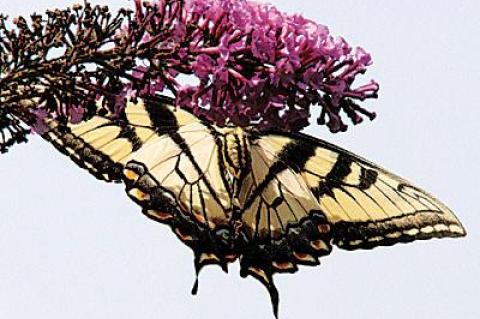 Nature Notes: Beautiful Butterflies
Nature Notes: Beautiful ButterfliesI’ve never heard anyone utter anything nasty about butterflies. About moths, yes, but not butterflies. In just about every other animal group, particularly within the many insect families, there are hordes of species — bedbugs, mosquitoes, yellow jackets, termites, carpenter ants, deer flies, weevils, locusts, what have you — that have been called every curse word in the book. But butterflies have been spared. Why?
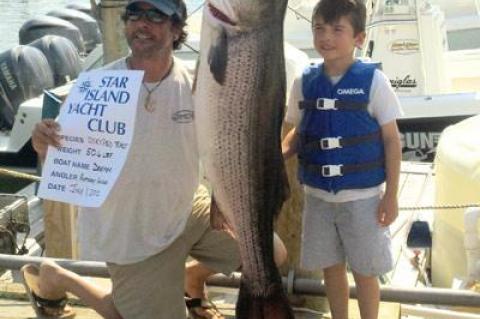 Striped Bass Are Back
Striped Bass Are BackThe big striped bass are here. Star Island Yacht Club has reported that three bass over 50 pounds were weighed in during the past week.
Scott Leonard, who runs the tackle section of the Yacht Club’s store, caught a 60.4-pounder on June 26. On Friday, Mike Ajello, fishing aboard the Susan A, reeled up a bass weighing 56.3 pounds, and on Sunday Anthony Vaccaro caught a 50.7-pound bass.
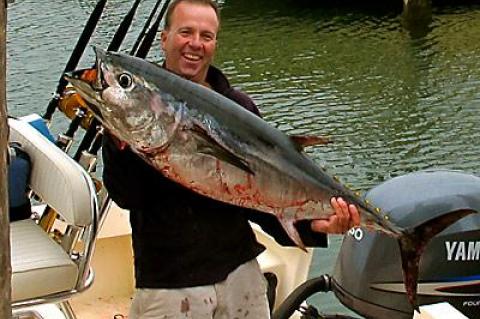 In the Cool Thermocline
In the Cool ThermoclineIf you are fishing in Gardiner’s Bay and spot what looks like a brown cloud just beneath the surface with a few flashes of reflected light near the surface, chances are it’s a school of bunker.
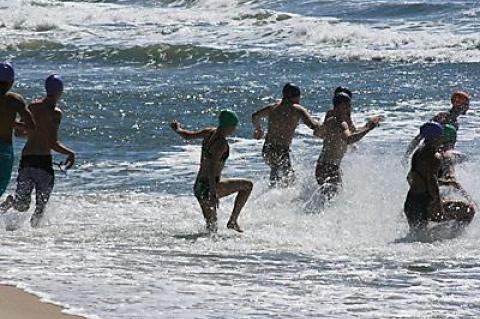 LIFEGUARDING: Ocean Test Draws 29
LIFEGUARDING: Ocean Test Draws 29The first ocean lifeguard test of the season, held at Indian Wells Beach in Amagansett on June 16, drew 29 hopefuls, a record number, said John Ryan Jr., the town’s chief lifeguard, who has been helping to oversee East Hampton’s beaches for 30 years.
All but two of those who took the arduous two-and-a-half-hour test passed. “We don’t say ‘failed,’ ” John Ryan Sr. said. “They can always take the test again and we urge them to.”
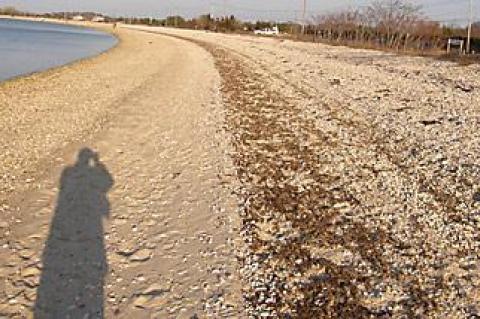 Nature Notes: Does It All Become Dust?
Nature Notes: Does It All Become Dust?The e-news just reported that sea level is rising on America’s East Coast faster than on the West Coast. What this translates into is the retreat of beaches and bluffs, the flooding of tidal wetlands, and the salting of drinking water wells situated close to the sea. On the other hand, while there will be losses and changes, there will also be more of the same.
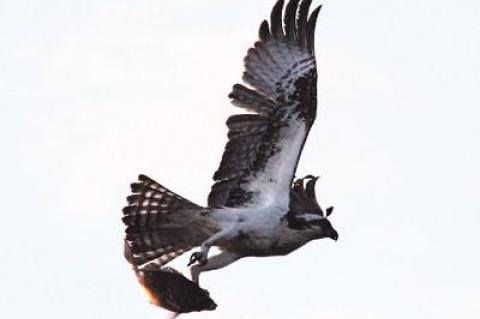 Nature Notes: Night Calls and Nightlights
Nature Notes: Night Calls and NightlightsI went out on Saturday evening to listen for whippoorwills. It was a quiet night and near 60 degrees. The conditions should have been ideal for calling wills, but between dusk and 10:15 I covered 23 miles of back roads in Noyac, Watermill, and Bridgehampton, stopping at least 20 times with lights and motor off and did not record a single whippoorwill.
The night sounds that I did hear, however, were compensatory. There were the long, fire siren buzzes of Fowler’s toads, the soft tremolos of gray tree frogs, and several different birdcalls and songs until it got dark.
 Three-Pounder With Attitude
Three-Pounder With AttitudeThey say mako sharks come and go according to the number of bluefish, their favorite dish, in the area. On Friday, the first day of the Star Island Yacht Club’s two-day shark tournament, 25 makos were caught.
True to form there seems to be a bumper crop of bluefish of all sizes, always a plus for vacationing neophyte anglers. Last weekend, a visitor from Queens booked a room at Lenhart’s Cottages in Montauk. Lenhart’s on Old Montauk Highway is a stone’s throw from the Atlantic Ocean.
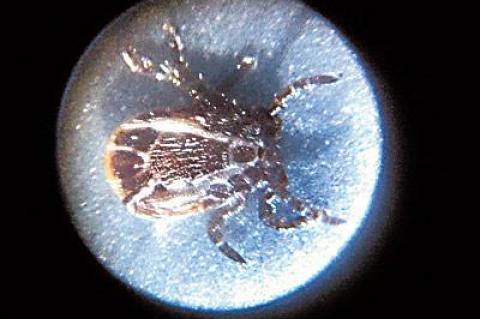 Nature Notes: Here an Itch
Nature Notes: Here an ItchOn Monday I found the first adult chigger, a k a harvest mite, climbing up the driver’s side door of my pickup truck. It was about the size of an adult deer tick and orangey. [Please see editor's note below.] Adult chiggers, themselves, are no cause for alarm, as they feed on plant material. It’s the thought of their babies that will emerge in August that distressed me, bringing to mind 26 years of annual chigger bite attacks here on the South Fork beginning in September of 1986.
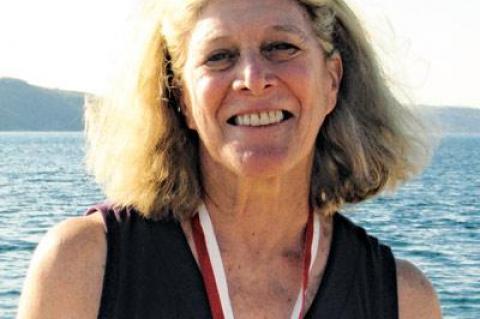 Lynn Sherr Loves the Water
Lynn Sherr Loves the Water“Not knowing how to swim here, is like not knowing how to drive at the Indy 500,” wrote Lynn Sherr in her newest book, “Swim: Why We Love the Water.”
The former WABC television correspondent was speaking of the East Hampton area, which she calls home for most of the summer. Also given praise in the book was the town’s junior lifeguard program, which made headlines this week when one of its trainees saved a drowning swimmer. “I am so impressed with them,” she said on Friday.
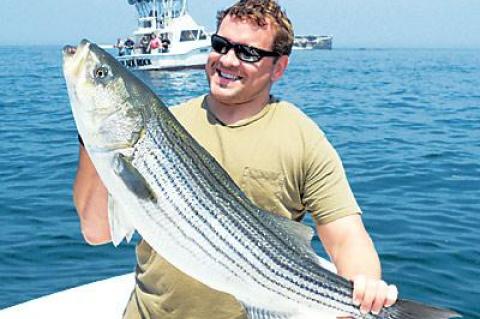 Beneath Celestial Bodies
Beneath Celestial BodiesKen Rafferty is a light-tackle and fly-fishing guide who sails out of Three Mile Harbor this time of year and moves to Montauk in the fall when the false albacore make their appearance.
In spring he likes to stalk striped bass as far west as Peconic Bay, with stops at places like Big and Little Gull Islands. Last week, he and his clients, James Kayler of East Hampton and Mike Tuscano of Amagansett, found plenty of stripers in Little Peconic Bay around Jessup’s Neck, and then bluefish galore at Cedar Point.
It is the season of procreation.
Arnold Leo called last week, concerned about a spotted white-tailed deer fawn, if not a newborn, then very close to it, that was sitting in the center of a yard near Georgica Pond on a property he had been caretaking. He was able to go up to it and touch it, and the fawn didn’t move a hair. He was worried it might have been abandoned, but as it turned out, the fawn had been “parked” by Mrs. Deer, probably while she was off foraging. She came back for it later on.
The Montauk Chamber of Commerce will hold the annual Montauk Old-Timers round-table discussion and dinner at the Inlet Seafood Restaurant on East Lake Drive on Tuesday starting at 4 p.m.
This year, Perry B. “Chip” Duryea III and Stuart Vorpahl will serve as historians to help put in perspective the observations of Jimmy Lester, Milton Miller, Teddy Stevens, Dave Krusa, John Rade, Bobby Byrnes, Scott Bennett, and John Nolan. Carl Darenberg of the Montauk Marine Basin will serve as moderator.
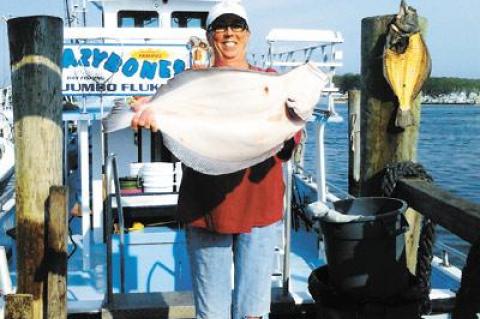 Doormats, Bass, Glowing Tuna
Doormats, Bass, Glowing TunaLast week, charter captains and private boaters sailing out of Montauk were finding striped bass, bass, bass. Nice plump ones. This week, the bass flurry slowed, but the slack was taken up by some doormat-size fluke and vast schools of bluefish. Then, there’s the news from California about radioactive bluefin tuna. Read on.
The Lazy Bones party boat has been hot with left-handed flounder with fish up to nine pounds. If you stand them on edge, summer flounder, or fluke, have both eyes on the left side; the upward-gazing eyes of winter flounder are on the right side.
It’s coming, it’s coming. This is the year of the Big One. Batten down the hatches and prepare to go without electricity for a week or so, or buy a generator ahead of time and have an electrician who knows what he or she is doing install it. Rising sea level and increased ferocity of storms is no longer a topic for idle discussion.
A week ago Thursday, Stephanie Baloghy, who lives in East Hampton, called to tell me that she had just found a baby box turtle slowly making its way over some leaf-strewn ground in her yard. She examined it as she has examined others in past years. This one had already used up the yolk sack (like our umbilical cord) that is found on the bottom shell of just-hatched turtles. No bigger than a quarter, it most likely hatched last fall but didn’t emerge until a few weeks ago.
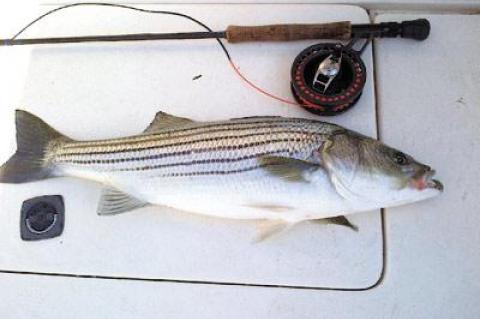 The One That Got Away
The One That Got AwayHarvey Bennett of the Tackle Shop in Amagansett can always be counted on for a fish tale or two. On Monday he related the adventures of one blowfish, a k a bottlefish or blowtoad.
Bennett said he was checking the waters just outside Fresh Pond in Amagansett for signs of fish when he observed a seagull pick a blowfish from the surface. Blowfish are swarming local waters this season, always good for a laugh and a very tasty dinner.
